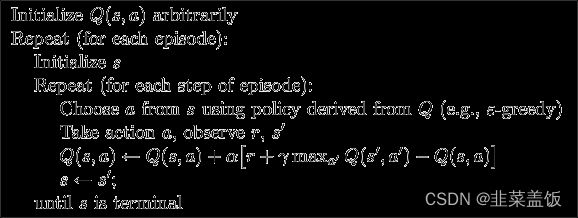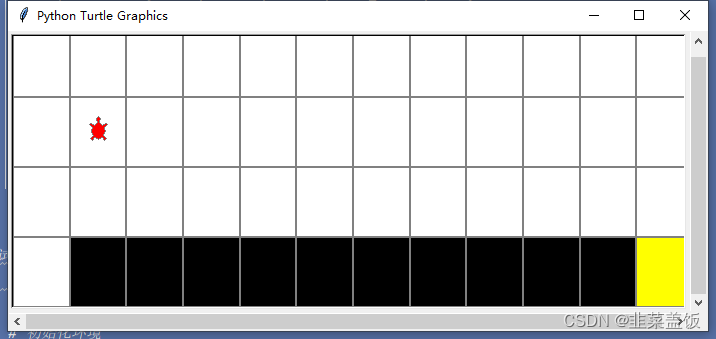强化学习------Qlearning算法
简介
Q learning 算法是一种value-based的强化学习算法,Q是quality的缩写,Q函数 Q(state,action)表示在状态state下执行动作action的quality, 也就是能获得的Q value是多少。算法的目标是最大化Q值,通过在状态state下所有可能的动作中选择最好的动作来达到最大化期望reward。
Q learning算法使用Q table来记录不同状态下不同动作的预估Q值。在探索环境之前,Q table会被随机初始化,当agent在环境中探索的时候,它会用贝尔曼方程(ballman equation)来迭代更新Q(s,a), 随着迭代次数的增多,agent会对环境越来越了解,Q 函数也能被拟合得越来越好,直到收敛或者到达设定的迭代结束次数。
伪代码如下:

整个算法就是一直不断更新 Q table 里的值, 然后再根据新的值来判断要在某个 state 采取怎样的 action. Qlearning 是一个 off-policy 的算法, 因为里面的 max action 让 Q table 的更新可以不基于正在经历的经验(可以是现在学习着很久以前的经验,甚至是学习他人的经验). 不过这一次的例子, 我们没有运用到 off-policy, 而是把 Qlearning 用在了 on-policy 上, 也就是现学现卖, 将现在经历的直接当场学习并运用. On-policy 和 off-policy 的差别我们会在之后的 [Deep Q network (off-policy)] 学习中见识到. 而之后的教程也会讲到一个 on-policy (Sarsa) 的形式, 我们之后再对比.
算法实战
我们使用openAI的gym中的CliffWalking-v0作为环境
#!/usr/bin/env python
# -*- coding:utf-8 -*-
import numpy as np
import gym
import time
import gridworld
#Sarsa算法
class QLearning():
def __init__(self,num_states,num_actions,e_greed=0.1,lr=0.9,gamma=0.8):
#建立Q表格
self.Q = np.zeros((num_states,num_actions))
self.e_greed = e_greed #探索概率
self.num_states = num_states
self.num_actions = num_actions
self.lr = lr #学习率
self.gamma = gamma #折扣因子
def predict(self,state):
"""
通过当前状态预测下一个动作
:param state:
:return:
"""
#获取当前状态的所有动作的切片
Q_list = self.Q[state,:]
#随机选取其中最大值中的某一个(防止存在多个最大值时,总是选最前面的问题)
action = np.random.choice(np.flatnonzero(Q_list == Q_list.max()))
return action
def action(self,state):
"""
选取动作
:param state:
:return:
"""
#探索,随机选择一个动作
if np.random.uniform(0,1) < self.e_greed:
action = np.random.choice(self.num_actions)
else: #直接选取最大Q值的动作
action = self.predict(state)
return action
def learn(self,state,action,reward,next_state,done):
cur_Q = self.Q[state,action]
# 当游戏结束时,不存在next_action和next_state
target_Q = reward + (1-float(done))*self.gamma*self.Q[next_state,:].max()
self.Q[state,action] += self.lr*(target_Q - cur_Q)
#训练
def train_episode(env,agent,is_render):
total_reward = 0
#初始化环境
state,_ = env.reset()
while True:
action = agent.action(state)
#执行动作返回结果
next_state,reward,done,_,_ = env.step(action)
#更新参数
agent.learn(state,action,reward,next_state,done)
#循环执行
state = next_state
total_reward += reward
if is_render:
env.render()
if done:
break
return total_reward
#测试
def test_episode(env,agent,is_render=False):
total_reward = 0
# 初始化环境
state,_ = env.reset()
while True:
action = agent.predict(state)
next_state, reward, done, _,_ = env.step(action)
state = next_state
total_reward += reward
env.render()
time.sleep(0.5)
if done:
break
return total_reward
#训练
def train(env,episodes=500,lr=0.1,gamma=0.9,e_greed=0.1):
agent = QLearning(
num_states = env.observation_space.n,
num_actions = env.action_space.n,
lr = lr,
gamma = gamma,
e_greed = e_greed
)
is_render = False
#先训练episodes次
for e in range(episodes):
ep_reward = train_episode(env,agent,is_render)
print('Episode %s : reward= %.1f'%(e,ep_reward))
#每执行50轮就显示一次
if e%50 == 0:
is_render = True
else:
is_render = False
#训练结束后,我i们测试模型
test_reward = test_episode(env,agent)
print('test_reward= %.1f' % (test_reward))
if __name__ == '__main__':
env = gym.make("CliffWalking-v0")
env = gridworld.CliffWalkingWapper(env)
train(env)
运行效果
另附工具类
用于可视化游戏界面
# Copyright (c) 2020 PaddlePaddle Authors. All Rights Reserved.
#
# Licensed under the Apache License, Version 2.0 (the "License");
# you may not use this file except in compliance with the License.
# You may obtain a copy of the License at
#
# http://www.apache.org/licenses/LICENSE-2.0
#
# Unless required by applicable law or agreed to in writing, software
# distributed under the License is distributed on an "AS IS" BASIS,
# WITHOUT WARRANTIES OR CONDITIONS OF ANY KIND, either express or implied.
# See the License for the specific language governing permissions and
# limitations under the License.
# -*- coding: utf-8 -*-
import gym
import turtle
import numpy as np
# turtle tutorial : https://docs.python.org/3.3/library/turtle.html
def GridWorld(gridmap=None, is_slippery=False):
if gridmap is None:
gridmap = ['SFFF', 'FHFH', 'FFFH', 'HFFG']
env = gym.make("FrozenLake-v0", desc=gridmap, is_slippery=False)
env = FrozenLakeWapper(env)
return env
class FrozenLakeWapper(gym.Wrapper):
def __init__(self, env):
gym.Wrapper.__init__(self, env)
self.max_y = env.desc.shape[0]
self.max_x = env.desc.shape[1]
self.t = None
self.unit = 50
def draw_box(self, x, y, fillcolor='', line_color='gray'):
self.t.up()
self.t.goto(x * self.unit, y * self.unit)
self.t.color(line_color)
self.t.fillcolor(fillcolor)
self.t.setheading(90)
self.t.down()
self.t.begin_fill()
for _ in range(4):
self.t.forward(self.unit)
self.t.right(90)
self.t.end_fill()
def move_player(self, x, y):
self.t.up()
self.t.setheading(90)
self.t.fillcolor('red')
self.t.goto((x + 0.5) * self.unit, (y + 0.5) * self.unit)
def render(self):
if self.t == None:
self.t = turtle.Turtle()
self.wn = turtle.Screen()
self.wn.setup(self.unit * self.max_x + 100,
self.unit * self.max_y + 100)
self.wn.setworldcoordinates(0, 0, self.unit * self.max_x,
self.unit * self.max_y)
self.t.shape('circle')
self.t.width(2)
self.t.speed(0)
self.t.color('gray')
for i in range(self.desc.shape[0]):
for j in range(self.desc.shape[1]):
x = j
y = self.max_y - 1 - i
if self.desc[i][j] == b'S': # Start
self.draw_box(x, y, 'white')
elif self.desc[i][j] == b'F': # Frozen ice
self.draw_box(x, y, 'white')
elif self.desc[i][j] == b'G': # Goal
self.draw_box(x, y, 'yellow')
elif self.desc[i][j] == b'H': # Hole
self.draw_box(x, y, 'black')
else:
self.draw_box(x, y, 'white')
self.t.shape('turtle')
x_pos = self.s % self.max_x
y_pos = self.max_y - 1 - int(self.s / self.max_x)
self.move_player(x_pos, y_pos)
class CliffWalkingWapper(gym.Wrapper):
def __init__(self, env):
gym.Wrapper.__init__(self, env)
self.t = None
self.unit = 50
self.max_x = 12
self.max_y = 4
def draw_x_line(self, y, x0, x1, color='gray'):
assert x1 > x0
self.t.color(color)
self.t.setheading(0)
self.t.up()
self.t.goto(x0, y)
self.t.down()
self.t.forward(x1 - x0)
def draw_y_line(self, x, y0, y1, color='gray'):
assert y1 > y0
self.t.color(color)
self.t.setheading(90)
self.t.up()
self.t.goto(x, y0)
self.t.down()
self.t.forward(y1 - y0)
def draw_box(self, x, y, fillcolor='', line_color='gray'):
self.t.up()
self.t.goto(x * self.unit, y * self.unit)
self.t.color(line_color)
self.t.fillcolor(fillcolor)
self.t.setheading(90)
self.t.down()
self.t.begin_fill()
for i in range(4):
self.t.forward(self.unit)
self.t.right(90)
self.t.end_fill()
def move_player(self, x, y):
self.t.up()
self.t.setheading(90)
self.t.fillcolor('red')
self.t.goto((x + 0.5) * self.unit, (y + 0.5) * self.unit)
def render(self):
if self.t == None:
self.t = turtle.Turtle()
self.wn = turtle.Screen()
self.wn.setup(self.unit * self.max_x + 100,
self.unit * self.max_y + 100)
self.wn.setworldcoordinates(0, 0, self.unit * self.max_x,
self.unit * self.max_y)
self.t.shape('circle')
self.t.width(2)
self.t.speed(0)
self.t.color('gray')
for _ in range(2):
self.t.forward(self.max_x * self.unit)
self.t.left(90)
self.t.forward(self.max_y * self.unit)
self.t.left(90)
for i in range(1, self.max_y):
self.draw_x_line(
y=i * self.unit, x0=0, x1=self.max_x * self.unit)
for i in range(1, self.max_x):
self.draw_y_line(
x=i * self.unit, y0=0, y1=self.max_y * self.unit)
for i in range(1, self.max_x - 1):
self.draw_box(i, 0, 'black')
self.draw_box(self.max_x - 1, 0, 'yellow')
self.t.shape('turtle')
x_pos = self.s % self.max_x
y_pos = self.max_y - 1 - int(self.s / self.max_x)
self.move_player(x_pos, y_pos)
if __name__ == '__main__':
# 环境1:FrozenLake, 可以配置冰面是否是滑的
# 0 left, 1 down, 2 right, 3 up
env = gym.make("FrozenLake-v0", is_slippery=False)
env = FrozenLakeWapper(env)
# 环境2:CliffWalking, 悬崖环境
# env = gym.make("CliffWalking-v0") # 0 up, 1 right, 2 down, 3 left
# env = CliffWalkingWapper(env)
# 环境3:自定义格子世界,可以配置地图, S为出发点Start, F为平地Floor, H为洞Hole, G为出口目标Goal
# gridmap = [
# 'SFFF',
# 'FHFF',
# 'FFFF',
# 'HFGF' ]
# env = GridWorld(gridmap)
env.reset()
for step in range(10):
action = np.random.randint(0, 4)
obs, reward, done, info = env.step(action)
print('step {}: action {}, obs {}, reward {}, done {}, info {}'.format(\
step, action, obs, reward, done, info))
env.render() # 渲染一帧图像
